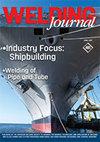水下湿焊的有限元分析:气泡形态的实现
IF 1.4
3区 材料科学
Q2 METALLURGY & METALLURGICAL ENGINEERING
引用次数: 2
摘要
为了合理地表征水下湿焊的特征,特别是高浓度热产生的气泡效应,建立了考虑气泡动力学与边界层相互作用的三维数值模型。将评估气泡生长过程的半经验方法作为边界条件纳入模型中,以解释热损失机制。结果表明,考虑气泡形态可以提高预测精度,预测的焊缝轮廓与实验结果吻合较好。为了揭示气泡结构在保持工艺变量一致性的同时的贡献,评估了气泡的等效接触半径及其浮动频率对温度场演化的影响。结果表明,较低的浮动频率和/或较高的等效接触半径有助于降低对水环境的热损失,延长t8/5时间,并提高焊缝宽度和接头熔深,这使得优化气泡动力学的作用是有益的。在其他相同的条件下,气泡的等效接触半径在促进熔池尺寸方面比气泡浮动频率起到更好的作用。基于量化的数据,可以为水下湿焊的气泡结构和热输入的匹配策略提供建议。本文章由计算机程序翻译,如有差异,请以英文原文为准。
Finite Element Analysis of Underwater Wet Welding: The Implementation of Bubble Configuration
To reasonably characterize the features of underwater wet welding, especially the bubble effect engendered from a high concentration of heat, a three-dimensional (3D) numerical model considering the interaction of bubble dynamics with the boundary layer was developed. A semi-empirical method assessing the bubble growth process was incorporated into the model as boundary conditions to account for the heat loss mechanism. It was proven that consideration of the bubble configuration can improve prediction accuracy, and the predicted weld profile was in good agreement with the experimental results. To reveal the contribution of the bubble configuration while maintaining processing variables consistency, the influences of the equivalent contact radius of the bubble and its floating frequency on the temperature field evolution were evaluated. The results showed that low floating frequency and/ or a high equivalent contact radius tend to depress the heat losses to a water environment, prolong the t8/5 time, and enhance the weld width and joint penetration, which render the role of optimized bubble dynamics beneficial. Under otherwise identical conditions, the equivalent contact radius of the bubble plays a much better role than the bubble floating frequency in promoting weld pool dimensions. Based on the quantified data, suggestions concerning the matching strategy of bubble configuration and heat input for underwater wet welding may be provided.
求助全文
通过发布文献求助,成功后即可免费获取论文全文。
去求助
来源期刊

Welding Journal
工程技术-冶金工程
CiteScore
3.00
自引率
0.00%
发文量
23
审稿时长
3 months
期刊介绍:
The Welding Journal has been published continually since 1922 — an unmatched link to all issues and advancements concerning metal fabrication and construction.
Each month the Welding Journal delivers news of the welding and metal fabricating industry. Stay informed on the latest products, trends, technology and events via in-depth articles, full-color photos and illustrations, and timely, cost-saving advice. Also featured are articles and supplements on related activities, such as testing and inspection, maintenance and repair, design, training, personal safety, and brazing and soldering.
 求助内容:
求助内容: 应助结果提醒方式:
应助结果提醒方式:


